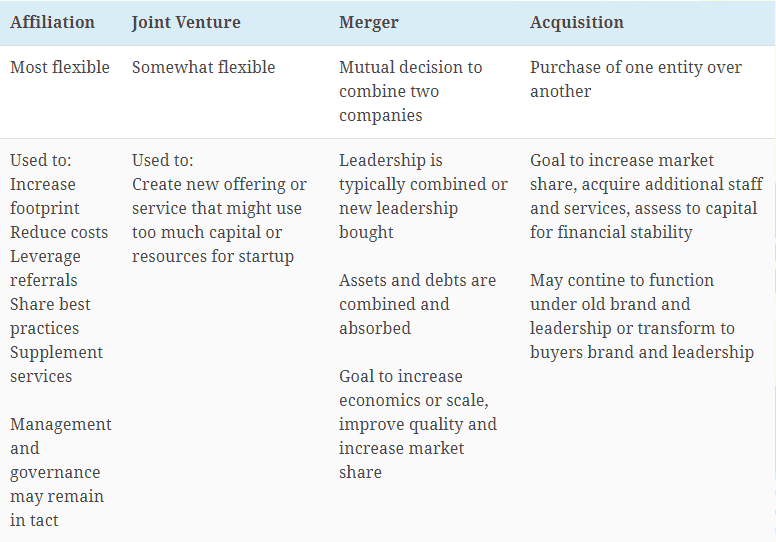Strategic Alliances
A significant industry trend picking up steam in the wake of healthcare reform is consolidation of healthcare businesses and facilities to create larger healthcare systems with a broader scope of services. By forming strategic alliances, hospitals and other large health care companies can service larger populations, combine the clinical and managerial strengths of each entity, increase purchasing power, and leverage economies of scale to offset increasing economic and regulatory pressures.
Common Alliances: Home Health and Hospice
Today, alliances are particularly common in the home health and hospice sectors. More hospitals and healthcare facilities are joining with providers of home health and hospice services to reduce costs and offer a more complete continuum of care to their patients.
Such strategic alliances can take various forms, including affiliations, joint ventures, mergers, and acquisitions. Each approach has its particular advantages and should be considered by healthcare executives as they plan the growth of their organizations. For example, affiliations offer flexibility in increasing the footprint of participating organizations because management of each remains intact. On the other end of the spectrum, acquisitions result in one organization being assimilated by another, but can be powerful in improving the buyer’s business, leadership, market share, and capital structure. The following table summarizes the different forms of strategic alliances.
One example of a successful hospice acquisition involves Scripps Health of La Jolla, CA, which entered the hospice market through the acquisition of Horizon Hospice in 2013. Scripps took this step after the bankruptcy filing of San Diego Hospice, which was not affiliated with Scripps and originally provided end of life care to Scripps’ patients. According to Chris Van Gorder, President and CEO of Scripps Health, Scripps was concerned about the potential total collapse of hospice care for its patients during the bankruptcy. Scripps therefore made the decision to enter the hospice business itself by acquiring Horizon. Van Gorder stated that healthcare in the future must become more integrated and providers like Scripps must either offer such care or collaborate with others to ensure a broad continuum of treatments.
Joining Forces in Health Care
Other hospitals are increasingly joining forces with home health and hospice as a way to coordinate care of patients through an integrated system. SCL Health in Denver decided to create a home health joint venture to extend services to patients beyond what the hospital had been able to provide. They partnered with Univita, a leading home health care provider, and now SCL Health works together with clinicians and families to improve the outcomes of the patients they serve. As hospitals seek to lower costs, reduce readmissions and improve the patient experience, relationships with seasoned providers like Univita are particularly important.
Home health and hospice providers can realize a number of benefits through formal relationships with hospitals or other health facilities. A recent example involves a joint venture between Tidelands Community Hospice and Georgetown Hospital system in South Carolina. The joint venture will allow each organization to benefit from the strengths of the other, and result in cost savings to both the hospital and the hospice. The hospital will be more proactive in the care of its patients and the hospice operation will benefit from reduced expenses including lower drug costs. The joint venture arrangement allows each entity to maintain its original identity, mission and goals while collaborating on the care of hospice patients. Both companies remain fully intact while the joint venture is created as a separate entity employing those people who work directly for the joint venture.

If you’re interested in learning more about how Fleetridge Pacific can help your healthcare business join forces with a larger healthcare provider, contact us today at (619) 523-0303 for more information.
Click Here to view or download this article in PDF-format.
